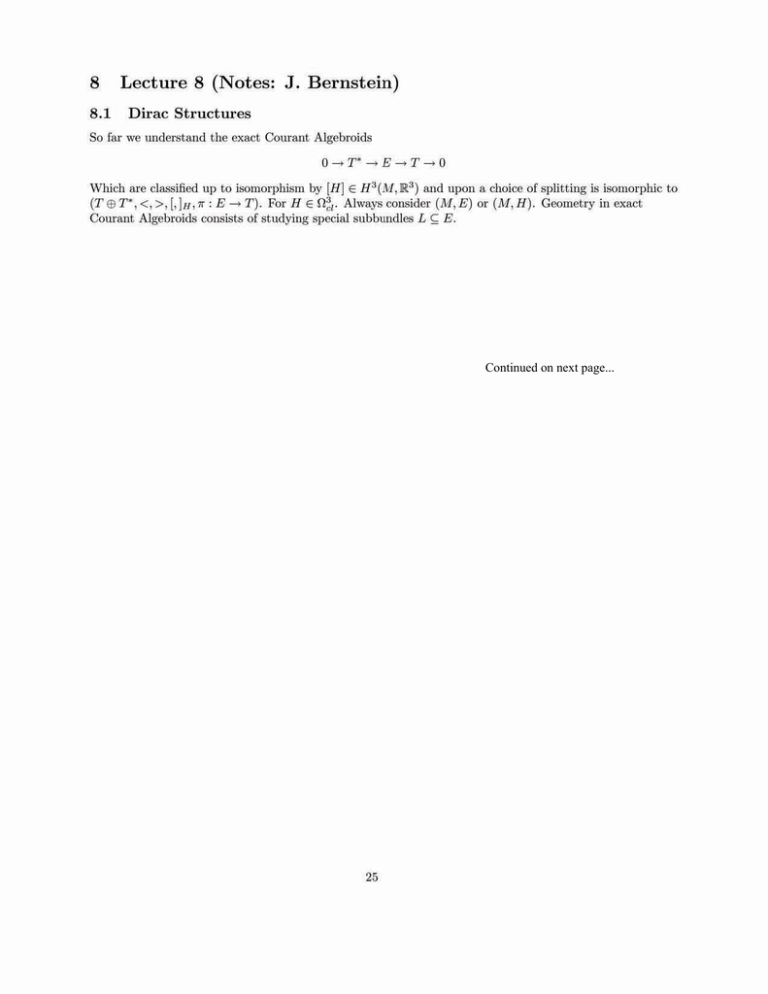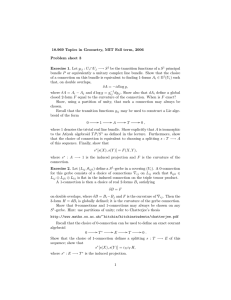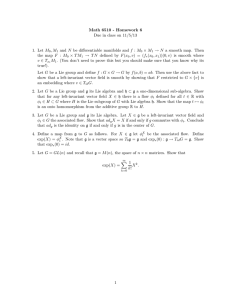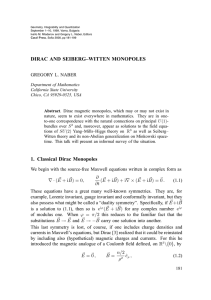Dirac Structures & Courant Algebroids Lecture Notes
advertisement

Continued on next page...
Theorem 6. Suppose that L ⊆ E a subbundle which is closed under [, ] (involutive), i.e.
[C ∞ (L), C ∞ (L)] ⊆ C ∞ (L). then L must be isotropic or L = π −1 (Δ) for Δ ⊆ T integrable distribution.
Note, for Δk ⊆ T , π −1 (δ) is of dimension n + k and contains T ∗ (so is not isotropic).
Proof. Suppose L is involutive, but not isotropic, then there exists v ∈ C ∞ (L) with < v, v >m �= 0. Now
recall property [f v, v] = f [v, v] − (π(v)f )v + 2 < v, v > df ⇒ 2 < v, v > df ∈ C ∞ (L) for all f , as
∗
[f v, v], f [v, v] ∈ C ∞ (L). This implies that dfm ∈ Lm for all m which tells us that Tm
⊆ Lm but T ∗ is
−1
isotropic so Lm = π (Δm ) for Δ �= 0. Thus rkL > n evertywhere and so L not isotropic at all points
p ∈ M thus Tp∗ ⊆ Lp for all p and so L = π −1 (Δ) where Δ is an integrable distribution.
So interesting involutive subbundles are isotropic subbundles L ⊆ E. Recall that the axioms of a Courant
Algebroid imply that [a, a] = 12 π ∗ d < a, a >. Thus on L, [, ]C |C ∞ (L) defines a Lie Algebroid when L is
involutive and isotropic. So L ⊆ E with [L, L] ⊆ L and < L, L >= 0 implies that (L, [, ], π) is a Lie
Algebroid which implies (C ∞ (∧∗ L∗ ), dL ) gives rise the HdL (M ) the Lie Algebroid Cohomology.
Definition 14. When an isotropic, involutive L ⊂ E is maximal it is called a Dirac Structure
Examples of Dirac structures in 0 → T ∗ → E → T → 0
• T ∗ ⊂ E as [T ∗ , T ∗ ] ⊆ [T ∗ , T ∗ ]
• If we split (T ⊕ T ∗ , [, ]H ) then [X, Y ]H ∈ C ∞ (T ) if and only if H = 0 so T ∈ T ⊕ T ∗ is a Dirac
structure if and only if H = 0
• Any maximal isotropic transverse L (that is such that L ∩ T ∗ = {0} is of the form L = ΓB . Since
eB [e−B ·, e−B ·]H = [·, ·]H+dB so eB [T, T ]H−dB = eB [e−B ΓB , e−B ΓB ]H−dB = [ΓB , ΓB ]H . Thus
[ΓB , ΓB ] ⊂ ΓB ] if and only if [T, T ]H−dB ⊆ T and this occurs if and only if H − dB = 0 so ΓB is
� 0 there is no Dirac complement to T ∗ .
Dirac when and only when [H] = 0. In particular when [H] =
• When Δ ⊂ T is an integral distribution then f : Δ ⊕ Ann Δ �→ T ⊕ T ∗ is involutive for [, ]H when
and only when f ∗ H = 0.
• For (T ⊕ T ∗ , [, ]H ) and β ∈ ∧2 T we consider Γβ . This is Dirac if and only if [β, β] = −β ∗ H where we
think of β : T ∗ → T .
Problem. Verify the condition for Γβ to be Dirac by first showing that [ξ + β(ξ), η + β(η)] = ζ + β(ζ) if
and only if < [ξ + β(ξ), η + β(η)], ζ + β(ζ) >= 0. And then showing that
< [df + β(df ), dg + β(dg)], dh + β(dh) >= {f, {g, h}} + {g, {h, f }} + {h, {f, g}} + H(β(df ), β(dg), β(dh)) =
(Jac{, } + β ∗ H)(df, dg, dh).
Definition 15. if [β, β] = −β ∗ H then β is called a twisted Poisson Structure.
Suppose that β is a twisted Poisson structure, then eB Γβ is not necessarily Γβ � , in particular if β is
invertible (as a map T ∗ → T ) and β −1 = B then e−B Γβ = T . However if B is “small enough” then
eB Γβ = Γβ � . To quantify this we note that eB : ξ + β(ξ) �→ β(ξ) + ξ + Bβ(ξ) which we want equal to
η + β � (η). This happens if and only if η = (1 + Bβ)ξ and also β(ξ) = β � (η) = β � (1 + Bβ)ξ. Thus
β � = β(1 + Bβ)−1 and so smallness just means that the map is invertible (i.e. what is written makes sense).
Definition 16. The transformation from β �→ β(1 + Bβ)−1 is called a gauge transform of β.
Problem. (S̆evera-Weinstein) Show that if β is Poisson and dβ = 0 then β � is Poisson. Also show that
Hβ· (M ) ∼
= Hβ· � (M ), (i.e. one has a isomorphsm of Poisson cohomology. (Hint: eB : Γβ → Γβ � is an
isomorphism of Lie Algebras).
26
8.2
Geometry of Lie Groups
Recall that for a Lie group G one has a natural action of G × G on G, given by (g, h) · x = gxh = Lg Rh x
(here one has a left action and a right action). These actions commute in that (gx)h = g(xh). Now for
g = Te G the lie algebra of G one has two identifications of g → Tg G namely a �→ aL |g = (Lg )∗ a and
a �→ aR |g = (Rg )∗ a where aL , aR are left and right invariant vector fields respectively. We have by
definition [aL , bL ]Lie = [a, b]L . Now if j : G → G is given by x �→ x−1 , then jLg = Rg−1 j so
j∗ (Lg )∗ = (Rg−1 )∗ j∗ . In particular since (j∗ )e = −Id, one has
(j∗ aL )g−1 = j∗ (Lg )∗ a = (Rg−1 )∗ j∗ a = −(Rg−1 )∗ a = −aR |g−1 . Thus j∗ aL = −aR . Thus
[aR , bR ] = [j∗ aL , j∗ bL ] = j∗ [aL , bL ] = j∗ [a, b]L = −[a, b]R . One also has [aL , bR ] = 0. To see this we note
d
that the map g → C ∞ (T G) given by a �→ aL |g = dt
(gγ(t)) exponentiates to a right action Rγ(t) similarly
R
L R
a exponentiates to a left action and so [a , b ] = 0.
We now define Adg : g → g by Adg (X) = (Rg−1 )∗ (Lg )∗ . Equivalently aR |g = (Adg−1 a)L |g . We define
adX = d(Adg )0 = [X, ·].
Lemma 1. If ρ ∈ Ωk (G) is bi-invariant then dρ = 0
Proof. If ρ is left invariant then ρ ∈ ∧k g∗ and so
�
�
dρ(X0 , . . . , Xk ) =
(−1)i Xi ρ(X0 , . . . , X̂i , . . . , Xk ) +
(−1)i+j ρ([Xi , Xj ], X0 , . . . , Xk )
i
i,j
, where we have chosen X0 , . . . Xk�
to be left invariant so the first sum is zero . On the other hand right
invariance tells us that for all X,
ρ(X1 , . . . , [X, Xi ], . . . , Xk ) = 0.
Problem. Show how the statement above implies that dρ = 0.
We define Cartan one-forms to be forms θL , θR ∈ Ω1 (G, g) by θgL (v) = (Lg−1 )∗ v ∈ g. and
L
θgR (v) = (Rg−1 )∗ v ∈ g. So θxL ◦ (Lg−1 )∗ = θgx
. Thus θL is left invariant as θR is right invariant.
L
−1
For G = Gln , g = Mn one has θ = g dg and θR = dgg −1 . Now if g = [gij ] that is gij are coordinates one
gets matrix of oneforms [gij ]−1 [dgij ]. Then (σg)−1 d(σg) = g −1 σ −1 σdg = g −1 dg, and so it is left invariant
(similarly one can check that the obvious definition is indeed right�
invariant). At 1 ∈ GLn one has g
consisting of n × n matrices {[aij ]} here we make think of [ai j] = i,j aij ∂g∂ij . so
�
g −1 dg( i,j aij ∂g∂ij ) = ai j, so g −1 dg|e = Id : g → g. This is also true for θL and θR .
9
Lecture 9 (Notes: K. Venkatram)
Last time, we talked about the geometry of a connected lie group G. Specifically, for any a in the
corresponding Lie algebra g, one can define aL |g = Lg∗ a and choose θL ∈ Ω1 (G, g) s.t. θL (aL ) = a. For
instance, for GLn , with coordinates g = [gij ], one has θL = g −1 dg, and similarly θR = dgg −1 .This implies
that dg ∧ θL + gdθL = 0 =⇒ dθL + θL ∧ θL = 0 =⇒ dθL + 12 [θL , θL ] = 0, the latter of which is the
Maurer-Cartan equation.
Problem.
1. Extend this proof so that it works in the general case.
2. Show j ∗ θR = −θL .
3. Show dθR − 12 [θR , θR ] = 0.
4. Show θR (aL )|g = Ad g a∀a ∈ g, g ∈ G.
27






